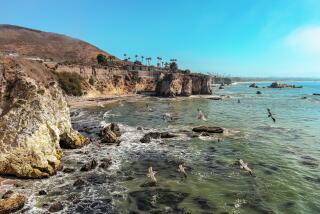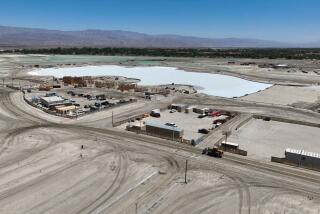Chula Vistans Risk Loss of Rare Species
- Share via
CHULA VISTA — Can the snake cholla hold its own against the march of progress? Can the San Diego barrel cactus coexist with condominiums? The City of Chula Vista hopes to prove that they can in one of the most extraordinary ecological niches in the county.
Rice Canyon is a jewel on the eastern arm of the city--60 acres of pristine canyon off East H Street near Interstate 805. Here, the high ridgelines and sharp valleys run east to west, carpeted in cactus and a rare commingling of northern and southern species.
The cooler, wetter, north-facing slopes are home to plants that are common in North County. On the hot, dry, south-facing slopes flourish plants more common in Baja California. Snake cholla and barrel cactus thrive. Botanists suspect that the rare San Diego ragweed may also be there.
To the north can be found pockets of Otay tar weed and San Diego thorn mint, endangered plants protected under state law. An intermittent stream has made the canyon floor almost riparian, lush with the green sweep of willow trees.
Now Rice Canyon is to be developed--another casualty in the crush to develop San Diego County’s South Bay. It is to become part of a development of more than 1,500 acres including 4,028 dwelling units, a business park, a school, and parks and open space.
The city has gone to great lengths to protect Rice Canyon’s slopes and floors, and the rare plants growing there. Only the ridgelines are to be developed, and some side canyons filled, while much of the main canyon is to be preserved.
Whether its rare quality can survive remains to be seen.
Already, runoff from older developments upstream has introduced foreign plants (which are to be removed in a city rehabilitation effort). New ridgeline development is likely to affect the slopes below, and dogs and cats will invade the canyon.
Then there is the matter of public access: The city hopes to offer trails and an interpretive center. But the question of how to balance public access with preservation remains to be answered.
Couldn’t development of the canyon simply have been banned?
“In order to do that, we’d have to purchase the property,” said Douglas Reid, the city’s environmental review coordinator. “We’re not in a position to do that. So there has to be some mechanism to maximize preservation under private development of property.”
That mechanism has been provided by new environmental laws and the environmental review process--tools that did not exist during earlier proposals for the area, which included a sports arena and shopping center, neither of which got off the ground.
“This particular proposal just happens to be in the right place at the right time,” Reid said. “ . . . If the (earlier) project had gone ahead as originally proposed, the canyon would not have been preserved. The entire area would have been developed now.”
More to Read
Sign up for Essential California
The most important California stories and recommendations in your inbox every morning.
You may occasionally receive promotional content from the Los Angeles Times.










